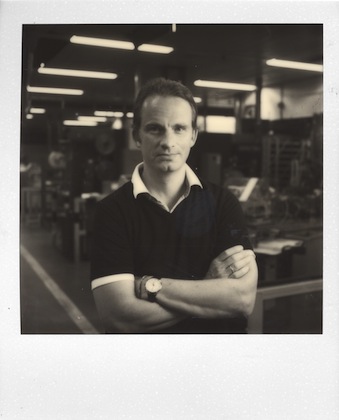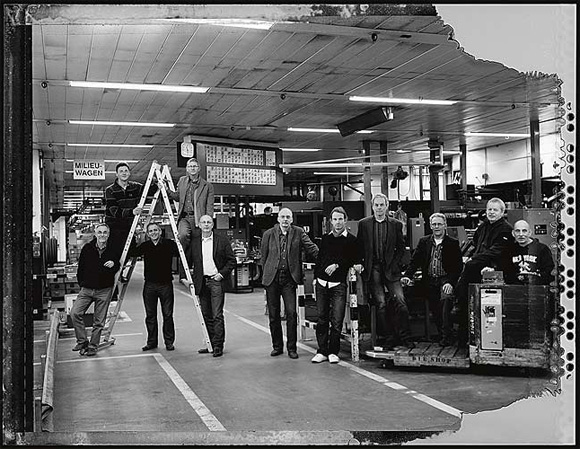In October 2008 Polaroid announced to shut down its last production plant for analogue film in Enschede (NL). Reason enough for graduated biologist and instant photography afficionado Dr. Florian Kaps to go for the impossible. Florian and his team managed to stave off destruction of the equipment and started planning their concept of how to make instant photography survive in the digital age. He collected money from friends, family and angel investors and leased the plant to start innovating film materials in 2010.
We had the chance to talk to the former leading manager of the Lomographic Society, that brought back the classic Russian Lomo Kompakt Automat and formed an international movement around it. Besides his passion for analogue, Florian manages to be an international marketing and sales guy with a true sense for communities. Today, Impossible produces completely new sorts of analogue film materials, like the Silver Shade (a newly developed b/w film), teaches its communities how to use them and showcases the best work in their galleries and concept stores.
DD: Florian, what’s your personal background?
FK: I’m 43 years old and was born in Vienna where I lived ever since und did a master in sciences. For five years I was one of the leading managers of the Lomographic Society in Vienna. In 2005 I stumbled across my first Polaroid camera. It was love at first sight and I decided to start my own business, fully dedicated to the mysterious magic of analog instant photography.
DD: You got a PHD in biology. Where did the link to analogue photography come from?
FK: You know how today’s curriculums are. One thing leads you to the other, and even though it’s not obvious at first sight what the connection is, all you ever did influences what you are doing now as it’s still a part of the person you’ve become. For my PHD I was working on the visual system of a South American spider with 8 eyes. So if you like, you can find the foundation for my visual passion there.
DD: In 2008 Polaroid decided to stop the production of instant flm in its factories. What drove you to take action and buy the polaroid factory? Can you describe the feelings you had in the time you made that decision?
FK: In 2008 I have already been running a successful business dedicated to analog instant photography for three years. We were selling Polaroid film and cameras, but also created a community platform and an art gallery dedicated to the media. The rediscovered passion for Polaroid photography was just about to grow, the worldwide demand for these anlog products was constantly rising.
When I heard Polaroid’s decision, I was flooded by several emotions: shock, depression, anger, disappointment and despair. One of the greatest inventions in the history of photography was about to die out! But after the very first paralyzation passed I realized that this was not the end but the chance for a new beginning! I decided that there was only one thing I couldn’t do – simply watch how this unnecessary catastrophe is happening. As there was nothing to loose, nothing to get worse, I tried to do the Impossible. At the very last minute we were able to purchase the original Polaroid plant in Enschede, the only place in the world were you could still find the complete production machinery. After we were able to call the plant our own, our team of former Polaroid employees started to do their work in order to reach our goal: to save analog instant photography and transfer it into the 21st century.
DD: As there’s many young startups out there today lacking investment. How did you manage to get the money together?
FK: The starting capital came from friends/family and business angels and accounted for 1,2 million Euros. During 2009, 2010 and 2011 those shareholders invested a total of €4,7mio. During 2012 Impossible raised significant funding to support its growth plans and investments into R&D of film and hardware development.
DD: First you led the lomographic society to a big international success, then The Impossible Project put a completely new positioning on the brand Polaroid. Where does your sense for marketing and branding come from?
FK: At lomography I learned a lot from the” World President” Mr. Fiegl regarding marketing and branding. But most important is to very closely connect and listen to your customers. The most important thing is to really be in deep love with your product, I’m involved in their creation and production process, I’m aware of every little detail. My sense for marketing and branding is defined by a real passion for the products, which brings me to the right feelings and actions when it comes to marketing them.
DD: What is the magic behind instant photography for its fans in your opinion?
FK: Today, digital photography has become a standard medium that no longer excites people as much as it used to do in its introduction years. People are getting bored by the millions of perfect pixel images that flood them everyday. We are oversaturated with digital images, they are nothing special no more.
Looking for special things that are real and valuable people are discovering analog instant photography as a medium that provides them everything they are looking for in a digital age – haptic, creative, unpredictable, unique and charming characteristics with an original outcome that you can’t duplicate but that you savor in its uniqueness with your closest ones.
DD: What’s your favourite Instant Camera Model / flm?
FK: I love my classic Polaroid SX 70 camera and I shoot it with our latest color film, the PX 70 Color Protection film. We’re all very proud of this film – it allows for easy shooting and delivers a never before-seen color saturation, bringing back the unique iconic performance and look of the most successful classic Polaroid films.
DD: Who’s your favourite photographer and why?
FK: There are several photographers that really fascinate me. some of them because of their personality, their history, their concepts, others because of the power of their images or their messages. Currently Araki San is one of my very favorite photographers.
DD: One fact, not everybody knows about you?
FK: I simply cannot resist grilling big steaks at every possible and impossible occasion.
DD: Did you ever have the chance to learn to know Dr. Edward H. Land, the founder of Polaroid and godfather of instant photography?
FK: I wish I would, but no! Dr. Edwin H. Land was an inventor and scientist years ahead of his time and an inspiration to many. He is definitely the invisible animating spirit behind the Impossible Project, whose name is even based on a quote by him: “Don’t undertake a project unless it’s manifestly important and nearly impossible.” Once I had to chance to meet his secretary who is 96 years old and spent some time to tell me some wonderful private stories about her former boss.
DD: Today, the Impossible project has concept stores in Vienna, New York, Tokyo, Paris and Warsaw. How’s the response to your brand in 2013?
FK: 2013 is young and we do yet have to wait to see what is to come. In any case, with our new hardware concepts that we plan to introduce this year, 2013 is going to be a most important year for us.
DD: Apps like Instagram and Hipstamatic established the analogue look on digital photography. Do you think that this helped bring a younger audience back to the topic of instant photography?
FK: It’s hard to say how many young people are guided from Instagram to a real analog instant camera. In any case this enormous trend reflects what I said before about people’s boredom with standard digital images – Instagram and Hipstamatic do at least lend your digital images something special.
DD: I just read the book „Retromania“ by Simon Reynolds, where he writes about the missing innovation in pop culture nowadays. Do you think that you are going against that trend by taking the old technology and reinventing it with your new sorts of instant flms?
FK: I’ve never considered our work retro as we had to be innovative from the very beginning – we invented a new film formula, we are creating new hardware, and also our users are not retro but very contemporary, dedicated to the moment and the creativity that they can experience and create therewith.
DD: Your current project „Polaroid Instant lab“ just got successfully fnanced on the crowdsourcing platform Kickstarter. How do you feel about it now and where do you see the connection between analogue and digital?
FK: We are currently about to start production of the pilot series, wherefore dozens of components from various suppliers are coming together – these days are truly exciting! I’m very much looking forward to launching the Instant Lab, which provides an easy and pure analog way to melt everyday’s iPhone images into unique, real and magic photographs, merging the digital with the analog world of photography.
DD: What’s your connection to digital technology in general?
FK: I love my iPhone and my MacBook Air, I’m curious to see what technology is coming up with these days. And I will always be using digital photography thanks to its easiness in handling and pricing. But for the special occasions in life I’ll always bring my Polaroid camera to capture unique moments in a unique way.
DD: What are the plans for the near future and is there a big vision for the Impossible Project?
FK: The launch of the Impossible Instant Lab and an Impossible Pinhole camera are our next major steps. The big vision for the future is that the Impossible Project becomes the worldwide focal point for all aspects of analog instant photography.
DD: Where do you see yourself in 20 years? Do you have something like a dream?
FK: I have many dreams. One of them is to open a small restaurant. At the walls there will be hundreds of instant pictures, carefully collected all over the world and all the next 20 years.
More information:
Impossible Project Website
Impossible Instant Lab on Kickstarter

Contributed by Manuel




